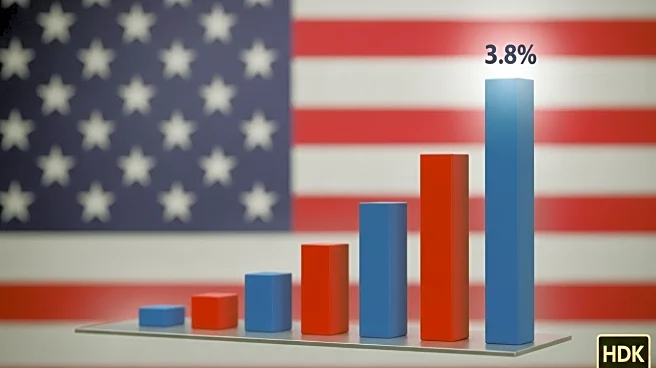What is the story about?
What's Happening?
Gold prices surged to an all-time high on Monday, driven by a weaker dollar and increasing expectations of further interest rate cuts by the Federal Reserve. Spot gold rose by 0.8% to $3,789.39 per ounce, after reaching a record high of $3,798.32 earlier in the session. U.S. gold futures for December delivery also saw an increase, rising 0.3% to $3,818.30. The U.S. dollar index eased by 0.2%, making gold more affordable for international buyers. The rise in gold prices is attributed to a benign inflation print in the U.S., which has led markets to anticipate further rate cuts by the Fed in October and December. Traders are currently pricing in a 90% chance of a Fed cut in October, with a 65% probability of another cut in December. Additionally, concerns over a potential U.S. government shutdown have contributed to cautious sentiment in share markets.
Why It's Important?
The record high in gold prices highlights the market's response to economic uncertainty and the potential for further interest rate cuts. Gold, a safe-haven asset, typically thrives in low interest-rate environments and periods of geopolitical and economic instability. The anticipation of rate cuts suggests that the Federal Reserve may be taking steps to stimulate the economy amid concerns over inflation and government fiscal policies. This development could impact various stakeholders, including investors seeking stable returns and industries reliant on economic stability. The potential U.S. government shutdown adds another layer of uncertainty, which could further influence market dynamics and investor behavior.
What's Next?
Investors are closely monitoring upcoming U.S. economic data, including job openings, private payrolls, the ISM manufacturing PMI, and the non-farm payrolls report, for further insights into the economy's health. These reports could provide additional clues regarding the Federal Reserve's future actions and the broader economic outlook. The possibility of a U.S. government shutdown remains a critical factor that could affect market sentiment and economic forecasts. Stakeholders, including policymakers and investors, will need to navigate these developments carefully to mitigate potential risks and capitalize on opportunities.
Beyond the Headlines
The surge in gold prices and the anticipation of interest rate cuts reflect broader concerns about economic stability and fiscal policy in the U.S. The potential government shutdown underscores the political challenges facing lawmakers and the implications for public services and economic growth. Long-term shifts in monetary policy could influence investment strategies and economic planning, with potential impacts on inflation, employment, and consumer spending. Ethical considerations regarding fiscal responsibility and governance may also come to the forefront as stakeholders assess the implications of these developments.
AI Generated Content
Do you find this article useful?













